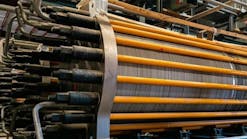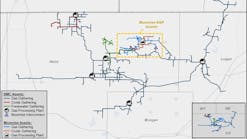L.R. Aalund
Managing Editor-Technology
One of the most beautiful island chains in the world offers both a very good market for petroleum products and intense environmental responsibilities.
Such is the case for BHP Petroleum Americas Refining Inc. and its 95,000 b/d Ewa Beach facility on the island of Oahu in Hawaii, a state rampant with magnificent beaches, green mountains, and tourists. They spend nearly $10 billion there annually. The only other refinery in the state is Chevron U.S.A. Inc.'s nearby Barbers Point refinery with a capacity of 52,000 b/cd.
BHP's market includes Hawaii (Fig. 1), distant American Samoa, and Guam. The refinery's market is dominated by the jet fuel burned by inter-island airlines and the huge air fleet that flies-in the tens of thousands of tourists from around the world, primarily from Japan and the U.S.
The refinery, with its 18,000 b/d hydrocracker, has been described as a "jet machine."
Because of its setting, the facility is also a "fin fan" refinery, using only air cooling. Nevertheless, to treat a relatively small amount of waste water the refinery this past March started up a new waste water treatment unit (WTU) that cost $22 million.
The unit, all of whose treating and separation units are aboveground, is monitored nearly as well as a refinery processing complex. The final step in the disposition of its treated water is unusual.
Another type of water is also a major environmental concern. The refinery gets all its crude oil supply via a single point mooring (SPM) in the blue waters off Oahu (Fig. 1).
The SPM is considered to be the safest type of offshore mooring because there are no long anchor lines to interfere with ingress or egress by the tankers.
This operation is monitored by instrumentation, and the personnel that conduct it onshore, and those on the tankers, are subject to strict rules and regulations.
REFINERY PROCESSING
In addition to the hydrocracker, BHP's refinery has a 40,000 b/d vacuum distillation unit, a 13,000 b/d catalytic reformer, a 17.6 MMscfd hydrogen generation unit, and a 13,000 b/d visbreaker.
Because of the attractive jet fuel market, "The name of the game," says Kevin Hofner, vice-president-refining operations," is to keep the hydrocracker filled."
Three sulfur recovery units equipped with Scott tail gas treating give the refinery 40 ton/day of sulfur recovery capacity. The recovered elemental sulfur is prilled into dry pellets for overseas shipping.
The refinery sends diesel or naphtha to a cogeneration unit and gets steam in return. BHP also owns and operates a synthetic natural gas (SNG) plant at the refinery, with a capacity of 16.7 MMcfd. This plant converts light naphtha into SNG.
Recently some 54% of the refinery's crude intake came from Alaska,s North Slope. The remainder came from: Indonesia, 18.0%; China, 10.6%; Australia, 6.3%; Malaysia, 6.2%; Papua New Guinea, 2.4%; and Ecuador, 2.4%.
The refinery's Australian parent company, BHP Petroleum, Melbourne, has a major stake in Australian production in Bass Strait and elsewhere down under. Nearly half of the input is therefore low-sulfur crude.
The crudes are run in a blocked operation, but the light ones are often mixed. The tank farm has a capacity of 2.2 million bbl of crude and 3 million bbl of refined products.
Typical product yields when running ANS crude are LPG, motor gasoline, 17%; jet fuel, 30%; diesel, 14%; and residual fuel oil, 34%. An outlet for this high-sulfur resid is the 1,400 b/d asphalt unit and ship bunkering in the vast, watery region.
The refinery delivers gasoline, jet fuel, and diesel through a 22 mile product line to Pearl Harbor, Honolulu airport, and Honolulu harbor.
WASTE WATER
The refinery generates normally about 330 gpm of waste water. The previous WTU also employed a traditional scheme, but the lagoons were in the ground and it did not have the advanced monitoring system that the new one has. All the equipment in the new WTU is now aboveground and enclosed. The treated effluent, as was the case in the older system, is injected via two wells with slotted pipe into a saline aquifer 65-95 ft below the surface. The quality of the waste water after treatment equals or betters the following values: oil and grease, 2 ppm; biological oxygen demand (BOD), 30 ppm; sulfide, 1 ppm; and pH, 6-9, according to plant management.
Fig. 2 is a diagram of the WTU flow scheme. The new system can handle the current flow rate of about 330 gpm. It is designed for a 25% increase in volume to handle any growth that may take place. The WTU system, which occupies about 3 acres of the total refinery site of 140 acres, is also designed on a modular basis with room for expansion. There are no cooling water towers in the refinery so none of the typical cooling tower water problems exist.
As shown by the flow diagram, the first step is the gross oil separator (GOS) which simply removes the free-floating oil. This step would be most important if there were a spill in a process unit that would overwhelm the classical API separator, which is downstream the GOS.
Both the GOS and API separator are covered (Fig. 3). The vapors from both units go to a thermal oxidation unit on site, where they are incinerated.
The next step, equalization, gives the operators the chance to store any material coming down the train that could harm the biological oxidation step. This material can be worked off separately at a slower rate.
After equalization, emulsified oil is removed at the induced air flotation unit (IAF). The water then flows to the stripping unit, which strips volatile hydrocarbons out of the water and sends them to incineration at 1,500 F.
Then the important biological oxidation system comes into play (Fig. 4). The unit also has a tank to keep microbes, which are periodically renewed, in reserve, should the front-line system go out of kilter. The equalization tanks, IAF, and stripping tanks are all redundant and covered. There are two 100% biological trains.
The WTU in essence breaks effluent into three components: hydrocarbons, treated water, and sludge. The latter consists of inorganics (sand and dirt) with absorbed oil. A fourth component, dead microbes or bacteria, are also a result of the treatment.
The points where these components are taken off are shown in Fig. 2.
As noted earlier, the separated oil is recovered and returned for processing, the treated water is injected, and the dead microbes (bio press cake) are sent to landfill.
The dewatered sludge, though, has just begun its trip. It is classified as a listed waste and there are no hazardous waste-handling sites in Hawaii to take it. BHP therefore must move it to the mainland U.S., over 2,000 miles away, by ship, for disposal at a licensed site.
Originally, BHP estimated, from the measured suspended solids and free oil content of the influent water, that it would need to dispose of about 3 tons/day of dewatered sludge at a cost of $2,000/ton. This works out to some $2.2 million/year. But to date, Joseph Moscatello, the refinery's supervisor of project and plant engineering, says significantly less oil sludge has been produced.
MONITORING AND CONTROL
The entire WTU is instrumented with the Elsag Bailey Group touch-screen control system and utilizes distributed Model OIS-20 consoles connected by fiber optic plant loops. The system is tied into the refinery information system. This means BHP personnel in Melbourne, Houston, or Honolulu, can pull up a screen and monitor the refinery and the WTU (Fig. 5).
The U.S. Environmental Protection Agency required that the treating processes be monitored and reported. A special long-term (1 year) moving average continuous algorithm helps in the standard reporting of effluent. Standard logging reports are provided on a daily basis.
Table 1 shows the sampling and analysis plan for the WTU and the sampling points given in Fig. 2. An operator takes all but one of the samples at the frequencies shown. All analyses, with the exception of permit tests, are done in the BHP laboratory. A contractor performs the monthly permit tests.
Table 2 lists the variables that can be monitored in the control room and identifies those that can be controlled.
CRUDE OIL BY SEA
The BHP refinery SPM is in 100 ft of water 1 1/2 miles off Barbers Point. Fig. 6 shows operations under way.
Tankers of up to 150,000 dwt carrying up to 800,000 bbl of crude oil can discharge over the SPM. It takes about 48 hr to discharge a load.
Bunker fuel and white products are shipped out at either the Barbers Point deep-draft harbor or over the SPM. Tankers and cruise and cargo ships provide a steady market for bunker fuel.
From 1987 through December 1993, 1,277 crude and product tankers called on the mooring.
The SPM buoy's top deck is designed to swivel, allowing a tanker to act like a weather vain and remain head-on in the wind. The tanker is secured to the mooring by an 18-in. circumference double hawser. In addition, a 4,000 hp chartered tug pulls on the tanker's stern during loading and unloading operations to prevent the vessel from riding up on the mooring.
All pilots navigating in the waters around BHP's SPM must be certified by the U.S. Coast Guard and have a federal pilot's endorsement on their Coast Guard license.
In crude oil unloading operations, three floating hoses 840 ft in length connect the tanker to the mooring and submarine hoses, which in turn are connected to the under-water pipelines going to the refinery's storage area. Safety measures at the mooring call for:
- Tight weather operating windows which give vessels more time to suspend operations and leave the mooring or delay approach in case of bad weather or sea conditions.
- Maintenance of vessel engines on immediate standby.
- Use of a geographical positioning system to establish precise ship location, speed, and direction.
- Monitoring with a remote device the ocean current and wind speed/direction at the mooring.
- Employment of breakaway couplings for each floating hose string of the SPM, which seal oil in the hoses in the event a tanker inadvertently breaks away.
- Continuous monitoring of the strain being placed on the mooring system.
The crude oil unloading rate and strain on the hawser are monitored in the pumphouse. The system is so sensitive that the effect of up-and-down wave action on the hawser strain can be seen on the screen. The warning system is alarmed to 75% of what is considered the allowable stress, which is about a 25% discount over the maximum. The SPM and floating hoses are the objects of a rigorous maintenance program.
If in spite of all this, should a spill occur, two organizations in which BHP is a member, the Clean Islands Council and Marine Spill Response Corp., are ready to move vessels, skimmers, and booms out to sea to contain and recover any spills. BHP's oceangoing tanker tug also is equipped for an initial response.
Joint exercises have been conducted. The most recent involved a scenario where a hose to a tanker ruptured, spilling 300 bbl of crude. The tanker was real, the oil was not.
Only the oil industry participants and the U.S. Coast Guard watched this exercise.
If the real thing happened, most of the world would be watching.
The primary objective in this exercise was environmental protection. But with some 90% of Hawaii's energy needs supplied by imported crude oil and products and the state's economy hanging on transportation fuels, there are other major ramifications related to the ocean transport of oil.
Copyright 1994 Oil & Gas Journal. All Rights Reserved.

